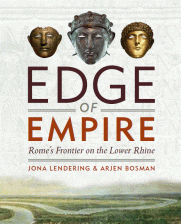
Antiochus IV
In the Biblical book of Daniel, the Seleucid king Antiochus IV Epiphanes (r.175-164) is presented as a monster and a blasphemer: ‘the king shall do according to his will; and he shall exalt himself, and magnify himself above every god, and shall speak marvelous things against the God of gods’ (11.36). The Greek author Polybius of Megalopolis (c.200-c.118) offers a similar judgment: ‘Antiochus surnamed Epiphanes gained the name of Epimanes [madman] by his conduct’, he writes (World History, 26.1), and continues with a catalog of mad acts.
There must of course be another side to the man, and the German historian Peter Franz Mittag has recently written an admirable book on the Seleucid king: Antiochos IV. Epiphanes. Eine politische Biographie (2006). It is a historical study as it should be. The author knows his sources – especially literary and numismatic – and also knows how to present them well.
After two introductory chapters and a chapter on Antiochus’ stay in Rome and coup, the fourth chapter deals with the empire at the beginning of his reign. It offers an interesting analysis of the (sometimes conflicting) political aims of the Seleucid administration, and an overview of its financial means. Mittag suggests that the yearly income was about 15,000 talents, which helps us understand that famous figure: that, according to the terms of the Peace of Apamea, the Seleucid Empire had to pay 1,000 talents to Rome every year. It was an immense sum, but it did not cripple the Seleucid economy. The Romans sheared their flock but did not skin it.
In the next two chapters, we read about the way in which Antiochus Epiphanes’ stabilized his power. Gifts to Greek towns created sympathy, which could be useful; embassies to Rome were equally important; Antioch benefitted from some building projects; and there were several cultic measures (there is no evidence for the forced introduction of a cult of Zeus Olympius). The assassination of Antiochus’ nephew, who might have claimed the throne, and a trip to the Phoenician cities are also presented as stabilizing measures.
No less than four chapters are devoted to the Sixth Syrian War. The first of these chapters describes Antiochus’ invasion of Egypt in 169, in which he reached Alexandria, which he found impossible to take. Next, we read about the ways the Seleucid king made his empire benefit from his victory: for example, a monetary reform served to improve conditions for trade. There is also a discussion of the status of Babylon in this chapter. The two remaining chapters deal with the second invasion of Egypt and Rome’s ruthless intervention. Mittag stresses that, although Antiochus was humiliated, it was not the disaster that Polybius says it was: the terms of the Apamea treaty appear to have been suspended – Rome did not complain about the Seleucid navy and Antiochus’ war elephants, even though they were forbidden.
The Maccabean revolt is the subject of the eleventh chapter. Mittag argues that Antiochus was – as always – especially interested in stabilizing and strengthening the empire, and supported the high priest Menelaus, who promised more tribute but was unable to keep this promise. When Antiochus realized his mistake, it was too late, but his consequent policy shows that he tried to restabilize the area. It might have worked, Mittag argues: general Lysias was able to pacify the area, and Judaea might have remained a province of the Seleucid Empire. However, Antiochus died and Lysias had to go to Damascus, which made it possible for the Maccabees to obtain their independence.
The festivities in Daphne (Polybius, World History, 30.25) receive a full chapter, and after this, we read about Antiochus’ anabasis to the east: he regained control of Armenia, visited Babylon, refounded Charax, visited Elam and Persis. The stories about his (unsuccessful?) looting of a temple are discussed, and presented as an attempt to regain arrears of tribute. Mittag finds no evidence for plans to attack Parthia and Bactria, and thinks that the town where Antiochus died was not Gabae/Isfahan, as is always believed, but a town with the same name in eastern Persis.
Cuneiform sources may one day settle this problem, which is important, because a visit to Gabae/Isfahan can be seen as a preliminary to a war against the Parthians, and a visit to Persian Gabae suggests that Antiochus was more interested in the Persian Gulf area.
 The fourteenth chapter deals with Antiochus’ death and succession; the last chapter offers a general assessment of this king’s rule. In Mittag’s view, he was especially interested in stabilizing and strengthening his kingdom – or, as Appian says, ‘he governed Syria and the neighboring nations with a firm hand’ (Syriaca, 45).
The fourteenth chapter deals with Antiochus’ death and succession; the last chapter offers a general assessment of this king’s rule. In Mittag’s view, he was especially interested in stabilizing and strengthening his kingdom – or, as Appian says, ‘he governed Syria and the neighboring nations with a firm hand’ (Syriaca, 45).
As I already said, Antiochos IV. Epiphanes. Eine politische Biographie is excellent. I would have liked to learn more about the introduction of the Roman-style soldiers that Mittag mentions in his account of the festival in Daphne, but that is only a minor quibble. Generally speaking, Mittag has reduced the biblical monster to more human proportions and reintroduced him into history as one of the most capable and efficient rulers of the Hellenistic age.
- Peter Franz Mittag, Antiochos IV. Epiphanes. Eine politische Biographie (= Klio: Beiträge zur Alten Geschichte. Beihefte, neue Folge Band 11) Akademie Verlag, Berlin, 2006. ISBN 3-05-004205-2; €69.80.



 Posted by Jona Lendering
Posted by Jona Lendering 
 Subscribe to feed
Subscribe to feed